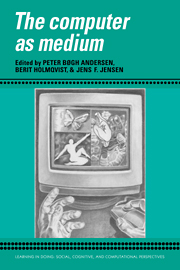Book contents
- Frontmatter
- Contents
- Series foreword
- Preface
- Contributors
- Part I Computer-based signs
- Part II The rhetoric of interactive media
- Introduction
- 6 Narrative computer systems: The dialectics of emotion and formalism
- 7 Interactive fiction: Artificial intelligence as a mode of sign production
- 8 Plays, theaters, and the art of acting in the eighteenth century: A formal analysis
- 9 The meaning of plot and narrative
- 10 Face to interface
- 11 Drawing and programming
- 12 Hypermedia communication and academic discourse: Some speculations on a future genre
- Part III Computers in context
- Index
10 - Face to interface
Published online by Cambridge University Press: 05 October 2010
- Frontmatter
- Contents
- Series foreword
- Preface
- Contributors
- Part I Computer-based signs
- Part II The rhetoric of interactive media
- Introduction
- 6 Narrative computer systems: The dialectics of emotion and formalism
- 7 Interactive fiction: Artificial intelligence as a mode of sign production
- 8 Plays, theaters, and the art of acting in the eighteenth century: A formal analysis
- 9 The meaning of plot and narrative
- 10 Face to interface
- 11 Drawing and programming
- 12 Hypermedia communication and academic discourse: Some speculations on a future genre
- Part III Computers in context
- Index
Summary
In the field of interactive fiction the concept of interaction is not just pertinent; it is crucial. An apparently trivial but nonetheless important problem arises every time we talk about interactive fiction. We do not know what to call the “user” of the system. It does not feel right to say that one is using a piece of fiction. So we sometimes say reader instead. But since we are mostly working with pictures and even with animation, it might be better to say viewer. But again there is something wrong. A reader and a viewer are physically passive, while a user of a computer system is active, by definition.
The problem of understanding what happens when people interact with computer systems is not a new one, nor is it specific to interactive fiction. In the history of traditional systems development and interface design, the problem has been tackled by the use of different metaphors. Although these metaphors have been fruitful within the context of non-fiction systems, they are part of a dysfunctional metaphorical inheritance that we must, if not get rid of, then at least try to transform into something workable. When we talk about interactive media, we are in fact stuck with at least three inherited and very different metaphors: a dialogue partner, a tool, and a media metaphor.
- Type
- Chapter
- Information
- The Computer as Medium , pp. 222 - 235Publisher: Cambridge University PressPrint publication year: 1994



